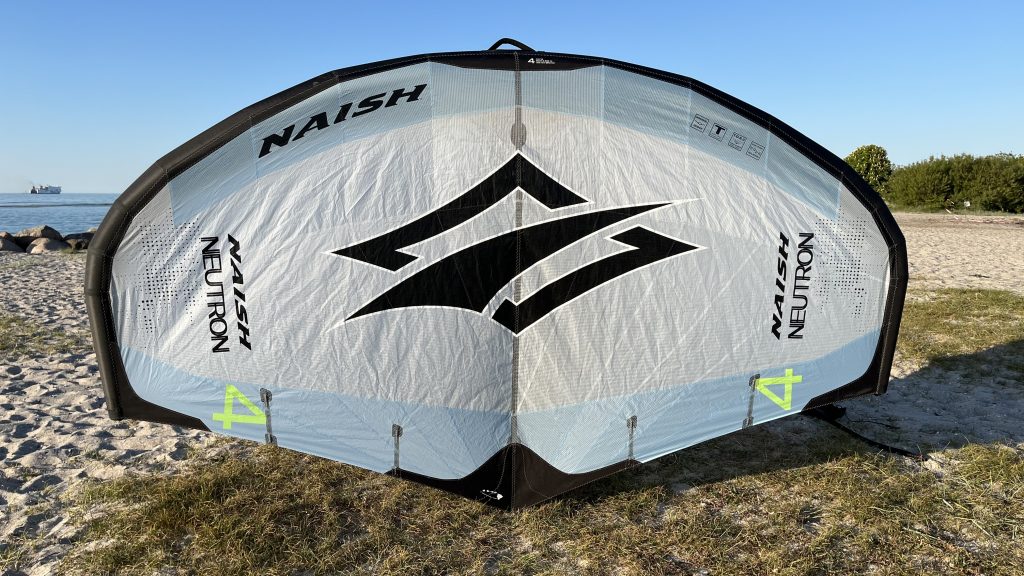The new Naish Neutron Wing has recently been on the market. We have already had the opportunity to test it extensively in the North and Baltic Seas.
The Neutron is designed for low-wind performance and maximum neutrality and covers the wave and freeride range. To achieve this, Naish has deliberately sacrificed maximum speed and performance. It is available in six sizes from 1.6 m² to 6.0 m².
On land
With the Neutron, Naish now also offers a pure boom wing. The 1 m long, removable boom can be used for all sizes. There are two tight-fitting loops on the middelstrut under which the corresponding counterpart on the bar is simply pushed under. The carbon boom is stabilized by the air pressure in the middelstrut.
The middelstrut is almost straight and only bends slightly towards the end. This is also where the cloth first lies directly against the middelstrut. The cloth is not quite as tightly stretched as on the ADX. All seams of the cloth end at the end of the middelstrut. There are two stabilizers on each side of the trailing edge, which gives the wing shape with a small batten.
The side profile of the Naish Neutron forms a slight V. The tips run parallel to the middlestrut for approx. 40 cm. The tips as well as the end of the middlestrut are reinforced against abrasion.
The Neutron is inflated via two SUP valves. As usual with Naish, the valves make a very high-quality impression. Middlestrut (8 to 10 PSI) and front tube (7 to 9 PSI) are separate from each other and must be inflated separately.
The wing has no windows. The bungee leash is kept quite short. Its mount on the wing for the leash has been additionally reinforced. The area behind the front handle is lined with neoprene.










On the water
We were lucky and were able to test the Neutron in its true medium, namely waves, off Hanstholm, Denmark, as well as on the Baltic Sea at home. On the wave, it follows in the neutral position in an exemplary manner. That is what you would expect from a wave wing. Really good!
The boom gives the handling a special kick. This also helps you in the wave, for example when it comes to jibing out of the wave and you can ride with one hand on the bar at critical moments.
Of course, the boom also helps with all other maneuvers such as tacking and normal jibing. Its neutrality mentioned above also has a positive influence on maneuvers. The wing lies calmly in the wind and only responds again when you want it to. The Neutron performs advanced maneuvers such as back riding or jumped 360s flawlessly.
When we first looked at the bar attachment, we had a little doubt as to whether it would be really stable. However, on the water, there is hardly any difference to bolted boom systems. The boom is firmly attached to the middelstrut.
Low-Wind-Performance
You can clearly feel Naish’s concept of focusing on absolute low-wind performance with the Neutron. In really low winds, it already gets going so that you can fly a smaller wing much earlier. As a result, the Neutron also reaches its limits more quickly in the upper wind range. The Naish ADX Wing can handle significantly more wind.
Its consistent implementation also means that the Neutron cannot gain as much height as its stablemate. The ADX also carries you a few meters higher into the air when jumping. On the other hand, the ADX also has to withstand more holding forces on the handlebars.
It is a pity that the Neutron was not equipped with windows. Although this may remain true to the line of a wave wing, it also prevents you from seeing what is happening on the other side. Which is not always helpful in a full line up.
The leash is a little short for our taste.



Conclusion
If you want to fly a smaller wing as fast as possible, value absolute neutrality and can do without maximum performance, the Naish Neutron is the perfect choice. The Neutron complements the Naish range very well. The boom works perfectly!
Thanks to its handling and low-wind characteristics, beginners will also really enjoy it. Wave junkies will especially like its neutrality.
One point of criticism is the lack of windows. In our opinion, every wing should have windows to prevent accidents on the water.







